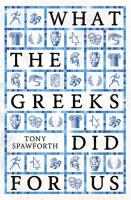
Yale University Press (2023) h/b 335pp £20 (ISBN 9780300258028)
S. is Emeritus Professor of Ancient History at Newcastle University and is no stranger to introducing classical civilisation to the general public. He has presented several documentaries for the BBC and his most recent book The Story of Greece and Rome (2018, also published by Yale) was admired for its liveliness and wit.
For this book he has chosen to identify the various ways in which Greek civilisation still significantly impinges on our lives today. ‘Greek’ he defines as primarily the mainland classical period from 500-300 BC and ‘us’ as primarily the Anglosphere (Britain and North America). He claims that the basis on which he has chosen topics to describe is wholly subjective but in so doing he refers frequently to the conclusions that others have drawn from the same material. Indeed another title for the book might have been ‘What they say that the Greeks did for us’. There are indeed a lot of ‘theys’, ranging from changes of view over time and differences of view within the same period.
Against this background he describes in thirteen different chapters the topics where he believes the Greeks still influence our lives today—politics, social attitudes, sex, oratory, education, history, poetry, religion, beauty, architecture, sport, and stage and screen. For each topic he engages in a rapid run over the field, drawing both on his professional academic background and his awareness of popular culture. He does not seek to adjudicate between the various views on the validity or the appropriateness of the conclusions that ‘they’ draw, although he tends to suggest that the antipathy currently being directed against the ‘Greeks’, particularly in America, cannot be readily brushed aside. The individual topics are framed by a prologue and an epilogue which seek to generalise the observations. There are also 23 pages of notes which primarily identify sources, required because he has banished footnotes. He provides 25 colour illustrations which seem rather random in their selection.
His style is eminently easy to read and to assimilate because S. wears the depth of his academic knowledge lightly. The focus of each chapter varies considerably. That on religion for example concentrates on the way in which the drafters of the Nicene Creed were influenced by the Greek philosophers and how the imagery of the early church built on the pagan art that it replaced. On the other hand the chapter on sport concentrates on the creation of the present Olympic Games where the classical precedents were frequently misunderstood by Baron Coubertin, deliberately distorted by Nazi Nuremberg, and other elements like the Olympic flame were simply invented.
In contrast he shows that influences from Greek architecture were meticulously researched and initially faithfully converted in the 18th century, only to be subsequently perverted by Mussolini and Trump. Similarly the chapter on oratory describes a consistent and well researched admiration for the Greek preoccupation with the craft (even if Lincoln’s Gettysburg address was achieved more by absorption than formal education).
Rather more weighty is the discussion on the influence of Greek politics (democracy, empire building) or social mores (racism, (slavery, male supremacy). This plunges us into the great binary divides of current academic debate. Here S. tends to set out the basis on which, and the language in which, the ‘theys’ of the past described their debt to the Greeks. If in so doing they happen to build their own scaffold—so be it.
This is a charming book which delivers a tremendous amount of information with great elegance. It is frequently conversational in tone and one imagines that S. enjoyed writing it. If it raises more questions than it answers that is not the fault of the author, because he did not set out to arbitrate. He undoubtedly establishes that the classical period of Greek civilisation was remarkably fertile in its power substantively to influence previous and current generations of European thought, whether through the understanding or misunderstanding of its messages and whether for good or ill. Even at its hard back price this is a book worth reading by either the general or the specialist reader.
Roger Barnes
